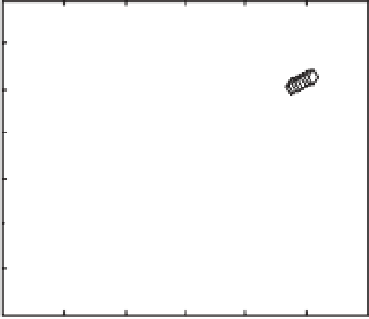Geoscience Reference
In-Depth Information
∼
570
K
lower than the melting temperature of
iron (T
mFe
=
In spite of the difficulties, several attempts were
made to determine the density and velocity of
materials forming the liquid outer core. The com-
pression curves of iron alloy melts such as Fe-Si,
Fe-S, Fe-C have been determined to ca. 10 GPa
(e.g., Sanloup
et al
., 2000, 2004; Nishida
et al
.,
2011a; Terasaki
et al
., 2010). The most important
constraints of the outer core are its density and
sound velocity. The density of the PREM outer
core is smaller than that of molten iron as dis-
cussed earlier. On the other hand, the velocity of
the PREM outer core is comparable to that of solid
pure iron and larger than that of liquid pure iron.
Figure 8.11 presents the Birch plot of the den-
sity and V
p
of the PREM outer core, and that of
crystalline pure iron. Because the compressional
velocity V
p
of molten iron is lower than that of
solid iron, we conclude that the light element
dissolved in the outer core reduces the density
of molten iron more significantly than the bulk
modulus under the core conditions.
6200 K) based on shock experiments
(Nguyen & Holmes, 2004), and
∼
720
K
lower
than that (T
mFe
=
6350 K) based on
ab initio
cal-
culations (Alfe
et al
., 1999). Therefore, if S and
O exist in the core, the ICB temperature corre-
sponds to the liquidus temperature of the Fe-O-S
alloy and will be 170-720 K lower than that
based on the melting temperature of pure iron. Be-
cause of the temperature in the outer core should
be close to the adiabat due to vigorous convec-
tion, the adiabatic decompression to the CMB
using the seismic Gr uneisen parameter of the
core (
γ
1.0-1.7, Anderson, 1998) could provide
the temperature at the CMB. Thus, the tempera-
ture at the core side of the CMB is estimated to be
3880
=
780 K, which is consistent with the tem-
perature of 3800 K estimated by mineral physics
data and seismic observations (Kawai & Tsuchiya,
2009), producing a heat flux of 5-15 TW, which
can sustain the geodynamo (Olson & Christensen,
2006). As discussed previously, there is a possi-
bility that the core contains other light elements,
such as Si and Ni. Because the presence of ad-
ditional elements in the core tends to lower
the melting temperatures, the temperatures es-
timated above for the CMB and ICB could be the
upper bound.
±
(a) Methods for density determination: X-ray
absorption and sink-float methods
Several
attempts were made to determine the density
12000
PREM Inner
core
8.3.3 Physical properties of iron-light
element melts
PREM
Outer core
10000
It has been suggested that the density of the outer
core is lower than that of pure iron under the
conditions of the core. Therefore, light elements
such as H, C, S, O, and Si may exist in the
outer core. On the other hand, the P-wave veloc-
ity, V
p,
of the outer core is higher than that of
molten and solid iron. The equation of state and
the sound velocity data of the molten metallic
iron and molten-iron-light element alloys com-
posing the outer core are still limited because of
technical difficulties, despite the intensive efforts
made to determine the melting curves of iron and
iron-light-element systems in order to provide
constraints for the temperatures at the ICB and
CMB as discussed in the previous section.
Shock compression
Brown & McQueen
(1989)
IXS Fiquet
et al
. (2001)
8000
NIRIXS
Mao
et al
.
(2001)
6000
8000
9000
10000 11000 12000 13000 14000
Density, kg/m
3
Fig. 8.11
The compressional velocity and density of
hcp-Fe, and the PREM outer and inner cores. The
compressional velocity of hcp-Fe was determined by
various methods, such as shock compression
experiments (Brown & McQueen, 1989), NIRIXS (Mao
et al
., 2001) and IXS (Fiquet, 2001).


